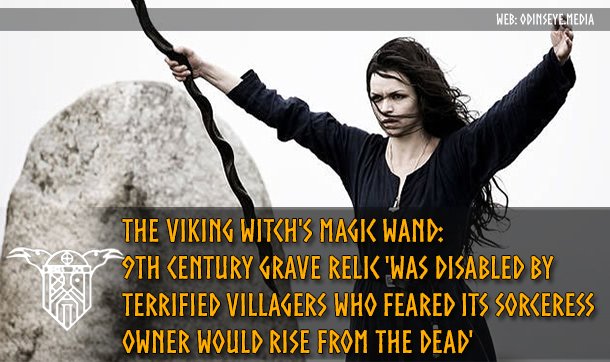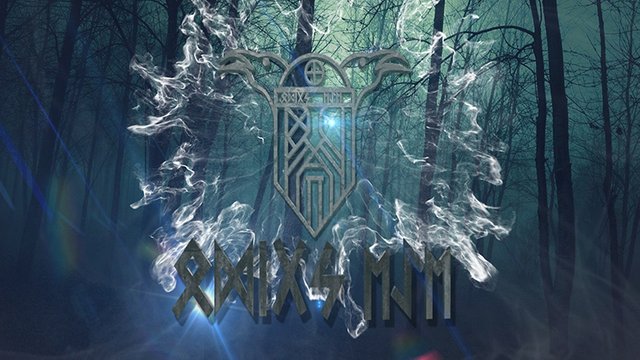The Viking witch's magic wand: 9th century grave relic 'was disabled by terrified villagers who feared its sorceress owner would rise from the dead'

A Viking metal rod which left experts baffled for more than a century has finally been identified as a 'magic wand' used by a witch to cast spells.
The staff, which was found in a ninth-century grave, is curved at the end - causing it to be misidentified as a fishing hook or a spit for roasting food.
However, archaeologists have now concluded that it was in fact a magical item belonging to a sorceress who was 'on the margins of society'.

They suggest that the reason it was bent before being buried with its owner was to remove its magical properties - possibly to prevent the witch coming back from the dead.
The 90cm-long rod has been part of the British Museum's collection since 1894, when it was discovered in Norway's Romsdal province.
It had been buried next to a woman's body alongside other valuable items including an unusual plaque made of whalebone, implying that the person in the grave had a high status in Viking society.
Its unusual shape, with a knobbly 'handle' and a hooked end, originally led historians to believe that it was a practical object used for catching fish.


They later decided that it was in fact a skewer for roasting meat - but after comparing the rod with other similar objects, experts have now reached a different conclusion.
British Museum curator Sue Branning says that it was probably a magical staff used to perform 'seithr', a form of Viking sorcery predominantly practiced by women.
'Our rod fits with a number of these rods that turn up in the ninth and 10th century in female burials,' she told The Times. 'They normally take the form of these long iron rods with knobs attached to them.'
The curve in the end of the staff is likely to have signified that it was being put out of use, a common practice in the medieval period for grave goods which were routinely broken when they were buried.
Bending or breaking the buried possessions of the dead could have served to neutralise their magical properties - preventing their former owners from casting spells from beyond the grave.
'There must have been some kind of ritual,' Ms Branning said. 'This object was ritually "killed", an act that would have removed the power of this object.'
Although Viking society, like most medieval societies, was dominated by men, some women were believed to have special powers which made them influential figures.
Ms Branning said: 'These women were very well respected, but they were quite feared as well. They may have been on the margins of society.'
Because the Vikings were not converted to Christianity until around 1000 AD, there is strong evidence for the importance of magic in their society at a time when the rest of Europe had largely abandoned the practice.


Runes, the pre-Christian writing system used in Scandinavia and elsewhere, have long been thought to have had magical associations and were apparently used to tell the future.
The witch's staff will go on display in the British Museum's new early medieval gallery, which is set to open on March 27.
The room will also contain highlights of the museum's collections including the Anglo-Saxon treasures found at Sutton Hoo.
SPELLS, SORCERERS AND RITUALS IN MEDIEVAL VIKING SOCIETY
Magical rituals are thought to have been central to many early medieval societies, but in most regions the advent of Christianity displaced them and obliterated all trace.
However, Scandinavia was not converted to Christianity until the late 10th and early 11th centuries, meaning that we have much more historical and architectural evidence about their pagan beliefs.
The magic apparently carried out by the owner of the British Museum staff is known as 'seithr', and was usually carried out by women sorceresses.
It was used for both peaceful and aggressive purposes - some practitioners claimed to use their skills to predict the future, but others cast spells to curse their enemies.
The runic alphabet, used to write Scandinavian languages before the coming of Christianity, is also thought to have had magical associations.
Roman author Tacitus described how Germanic priests would write symbols on pieces of bark before casting them as lots to tell the future, while the great god Odin was said to have had special skills in rune-reading and divination.
After Christianity came to the Norse world, traditional magic began to die out - but only after the old and new faiths went through a period of conflict.
The 10th-century King Hakon of Norway was brought up a Christian, but after ascending to the throne he found himself pressured to take part in pagan rituals which involved eating horse liver at a pubic feast.
Further reading and sources

Thank you for sharing!
Hopefully the Sorceress was that hot! I will keep believing.
LOL! She probably was. ;)